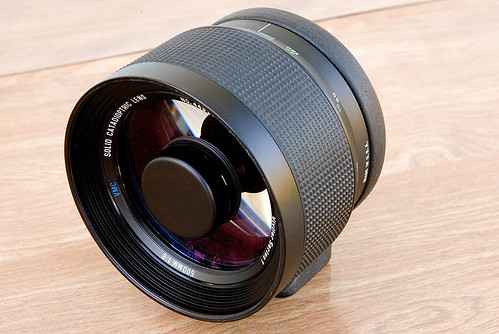Mirror lens
| ||
|
Mirror lenses, or catadioptric lenses, combine curved mirrors (catoptrics) with glass lens elements (dioptrics). Used only for telephoto lenses, the design provides a much shorter, lighter, and less expensive lens than a comparable conventional telephoto lens.
In spite of some advantages, optical shortcomings mean that they have never been very popular for general photography.
Construction
The short broad shape of a catadioptric lens is very distinctive, as is the back of the secondary mirror visible at the front of the lens. Light is reflected by the primary mirror at the rear of the lens onto the much smaller secondary mirror and from it through conventional optics onto the film or sensor. This double folding of the light path makes the lens very short for its focal length. The large primary mirror provides most of the magnification.
Usually hollow internally, some versions had the main mirror and front plate made from a solid block of glass.
Advantages
Relatively small size and light weight are the main advantages for a photographer. The catadioptric design provides a very high degree of optical correction, making such lenses popular for astronomy.
Disadvantages
The optical design precludes fitting a diaphragm and the aperture of these lenses is always fixed. Light adjustment can only be by use of neutral density filters giving no control over depth-of-field, which is always minimal.
Catadioptric lenses have relatively low contrast, quite acceptable for astronomy but a severe drawback for general photography. In addition, out-of-focus highlights will appear as doughnut shapes, distinctive and not always pleasing.
Erwin Puts testing a Minolta mirror lens commented "The end result does not deliver excellent image quality"[1]
Notes
- ↑ Erwin Puts Leica Lens Compendium 2001 Hove Books. ISBN 1-897802-17-X page 197.

